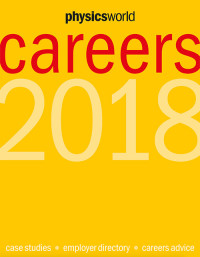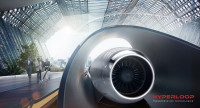Tag archives: industry
Got your physics degree… now what?
Last year, we launched our first ever Physics World Careers guide, which brought together all of our best content from the careers section of our monthly magazine, together with an extensive directory of employers. This year, we’re back with the bigger Physics World Careers guide 2018, packed with case-studies and analyses, to help you choose the right path for your future – as James McKenzie, vice-president for business at Institute of Physics point out in his foreword for the guide, “As physicists, you will have learnt to be logical, analytical and articulate. These are skills that are highly prized by employers and open up many career paths for you.”
View all posts by this author | View this author's profile
A virtual tour of virtual reality
By Margaret Harris at Photonics West in San Francisco
“How many people in this room are wearing smart glasses today?”
When Bernard Kress, a photonics expert and optical architect on Microsoft’s HoloLens smart-glasses project, posed this question at the Photonics West trade show, he had reason to expect a decent response. He was, after all, speaking at a standing-room-only session on virtual reality, augmented reality and mixed reality (VR, AR and MR), and the audience was packed with tech-friendly, early-adopter types who had come specifically because they’re interested in such devices. Surely, someone in the audience would put up their hand.
View all posts by this author | View this author's profile
Name that column
By Margaret Harris
Covering the commercial side of physics has its challenges. Because physics is such a diverse subject, people who train as physicists find their way into a host of different industries. Once there, they tend to blend in with graduates of other scientific disciplines, who are both more numerous and more likely to have their field in their job title: “physicist” is a relatively uncommon title compared to, say, “engineer”. It also doesn’t help that companies, unlike universities, almost never encourage employees to set up official, publicly accessible websites with contact info and details of what they’re working on right now.
But just because something is difficult doesn’t mean it shouldn’t be done, and one of Physics World’s resolutions for 2018 (right behind laying off the biscuits and getting more exercise) is to put more emphasis on covering industrial and applied physics. As part of that, we’re introducing a new column in the magazine that will explore the interactions between physics, industry and business in general. In this way, we hope to raise the profile of physicists in industry and, by extension, to emphasize the value that physicists bring to the commercial sector.
View all posts by this author | View this author's profile
Reviewing a year in industry
By Margaret Harris
Normally when someone talks about their “year in industry”, they’re referring to a period spent working for a company. My own “year in industry” has been rather different: instead of spending 2017 working in a physics-based industry, I’ve been reporting on half a dozen different ones. From nuclear energy and nanotechnology to optics and instrumentation, I’ve heard from physicists who’ve founded new firms, developed new products and navigated their way through tricky waters with financial backers. Here are a few highlights.
2017 was another high-profile year for physicist and entrepreneur Elon Musk, with his company SpaceX landing a re-used Falcon 9 rocket back in March and his other firm, Tesla Motors, starting to deliver its much-anticipated Model 3 to mere mortals just this week. But in between, there was also a little bit of hype about Musk and hyperloops: vacuum-based systems that could, according to proponents, transport passengers cheaply at more than half the speed of sound. It sounds far-fetched, but as Jon Cartwright revealed in this feature article for August’s Physics World Focus on Vacuum and Instruments, it’s an idea with a long history.
View all posts by this author | View this author's profile
Grabbing a slice of the pie in the sky
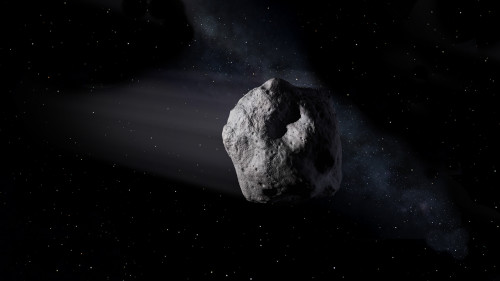
(Courtesy: NASA)
By Margaret Harris at the European Planetary Science Congress in Riga, Latvia
If you wanted to mine an asteroid, what would you need? Right now, it’s a hypothetical question: only a handful of spacecraft have ever visited an asteroid, and fewer still have studied one in detail. As commercial ventures go, it’s not exactly a sure thing. But put that aside for a moment. If you wanted to create an asteroid-mining industry from scratch, how would you do it?
Well, for starters, you’d need to know which asteroids to target. “Not every mountain is a gold mine, and that’s true for asteroids too,” astrophysicist Martin Elvis told audience members at the European Planetary Science Congress (EPSC) yesterday. For every platinum-rich asteroid sending dollar signs into investors’ eyes, Elvis explained there are perhaps 100 commercially useless chunks of carbon whizzing around out there, and the odds for water-rich asteroids aren’t much better. Moreover, some of those valuable asteroids will be impractical to mine, either because of their speed and location or because they’re too small to give a good return on investment. “Smaller asteroids aren’t even worth a billion dollars,” Elvis scoffed. “Who’d get out of bed for that?”
View all posts by this author | View this author's profile
A spotlight on accelerators in industry – sort of
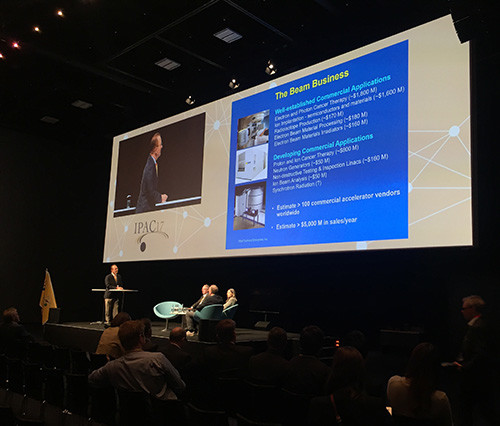
Robert Kephart of Fermilab speaking about the “beam business” at IPAC17.
By Margaret Harris at the International Particle Accelerator Conference in Copenhagen
Normally, you’d expect a particle-accelerator conference to focus on research – either the fundamental research done at accelerator facilities around the world, or the applied research required to get such facilities up and running in the first place. And for the most part, that has been absolutely true of the 8th International Particle Accelerator Conference (IPAC), which is taking place this week on the outskirts of Copenhagen, Denmark.
On Tuesday, however, the conference organizers dedicated a session to the ways that accelerator science engages with industry. In a two-hour series of talks, audience members heard from speakers as varied as Bjerne Clausen, CEO of the Danish chemical technologies firm Haldor Topsoe; Bob Kephart, director of the Fermilab-affiliated Illinois Accelerator Research Center (IARC); and Giovanni Anelli, who leads the Knowledge Transfer group at CERN.
View all posts by this author | View this author's profile
Following the ups and downs of nuclear energy
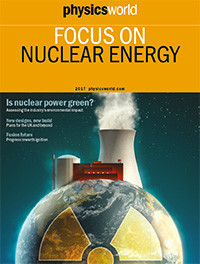 By Margaret Harris
By Margaret Harris
If you’re finding the pace of geopolitical news a bit too rapid at the moment, spare a thought for physicists and engineers working in the nuclear energy sector.
Towards the end of last month, the venerable energy firm Westinghouse Electric issued a press release in which it proudly announced that its AP1000 reactor – a relatively new “passively safe” design in which the reactor core is kept cool without the need for powered pumps or other “active” equipment – had passed a major UK regulatory review. Ordinarily, this would be cause for celebration. The so-called “Generic Design Assessment” process takes years, and completing it helps pave the way for building AP1000s within the UK. An international partnership called NuGen has long hoped to do just that, on a site near Sellafield in north-west England, so in normal times, you might expect it to be celebrating, too.
The STAR of the show
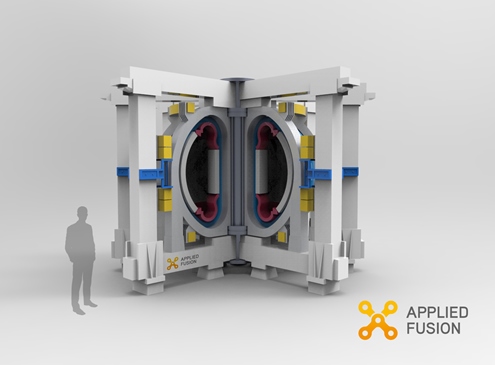
Grand designs. (courtesy: Applied Fusion Systems)
By Michael Banks
You may remember in 2014 when we reported that entrepreneur Richard Dinan – a former star of the UK reality-TV programme Made in Chelsea – was venturing into fusion energy.
He founded the firm Applied Fusion Systems with the aim of building a prototype fusion reactor. The 30 year old, who doesn’t have a university degree, claims to have taught himself tokamak design and employs a small team of scientists who are working on a design.
Well, the firm has now released its first blueprint for a spherical fusion tokamak and is seeking £200m in investment to build not one, but two of the machines.
View all posts by this author | View this author's profile
US immigration and trade policies provoke debate at Photonics West

San Francisco’s Golden Gate Bridge welcomes scientific visitors to Photonics West – except for those banned from travelling to the US.
By Margaret Harris at Photonics West in San Francisco
“I’m an immigrant. I stole one American job. I helped create hundreds of thousands of others.”
Deepak Kamra’s words caused a stir among listeners at Photonics West, the massive industry trade show and scientific conference that descends on San Francisco, California each winter. Speaking at a panel discussion on “Brexit, US Policy, EU and China,” the Delhi-born veteran of the Silicon Valley venture capital scene said that he expected the new US administration – which recently imposed a travel ban on visitors from seven majority-Muslim countries – to target Asian and South Asian technology workers next. Restrictions on the number of foreign-born students studying science, technology, engineering or mathematics (STEM) at US universities could follow. Ultimately, Kamra concluded, “We are going to lose a lot of qualified people.”
View all posts by this author | View this author's profile
To the stars, through adversity
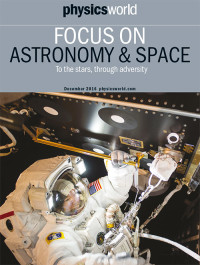 By Margaret Harris
By Margaret Harris
Space is, famously, “the final frontier”. It is also – almost as famously – “hard”. We saw this most recently in October, when the Schiaparelli lander crashed onto the surface of Mars, but throughout humanity’s nearly 60-year history as a spacefaring species, our hopes of exploring and observing the cosmos have repeatedly come up against the stiff challenge of building vessels that can survive the journey. Arguably, no other industry on Earth (or indeed off it) has rejoiced in such high “highs”, or agonized through such low “lows”.
That mix of heady dreams and harsh realities is one reason why the latest Physics World focus issue on astronomy and space science carries the tag line “To the stars, through adversity” (I’ll come to the other reason at the end of this blog post). The articles in the issue – which you can read free of charge – pay tribute to the ingenuity of the scientists and engineers involved in the challenging and rewarding practical work of exploring and observing the cosmos. Here, you can learn about the latest advances in astronomical instrumentation, get up to speed with future space missions, and familiarize yourself with recent developments in the entrepreneurial “new space” industry.
View all posts by this author | View this author's profile
